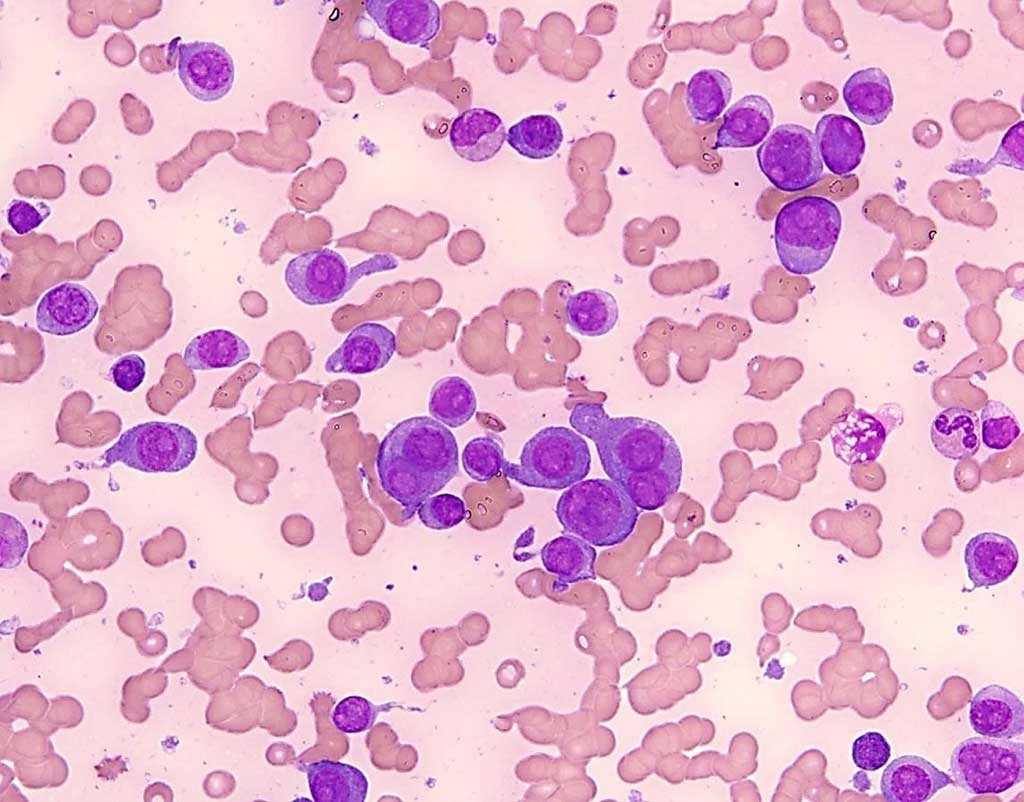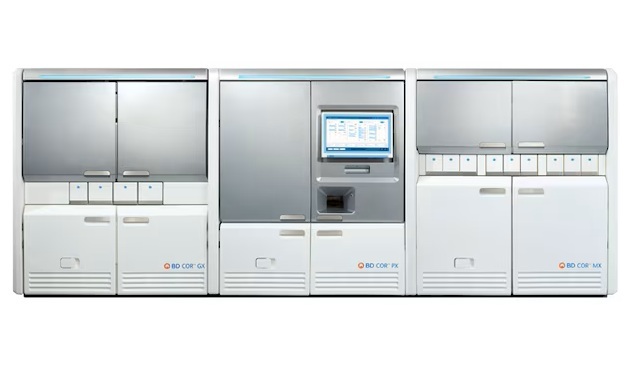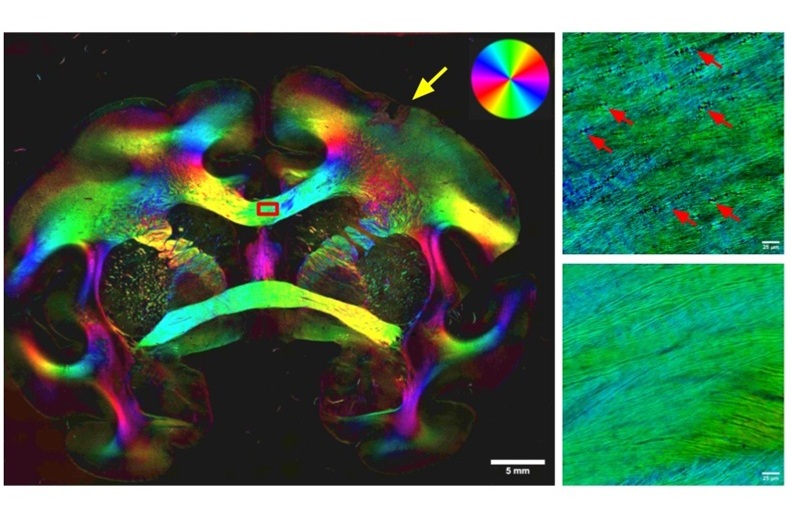Inherited Causes of Clonal Hematopoiesis in Multiplicity of Whole Genomes
|
By LabMedica International staff writers Posted on 29 Oct 2020 |

Image: Mutations in cell free DNA (cfDNA) or cells in the peripheral blood along with anemia or thrombocytopenia are the hallmark of myelodysplastic syndrome (MDS). The diagnosis of MDS is confirmed when mutations in hematopoietic cells are detected at relatively high levels (Photo courtesy of Genomic Testing Cooperative).
The age-related acquisition of somatic mutations that lead to clonal expansion in regenerating hematopoietic stem cell populations has recently been associated with both hematological cancer and coronary heart disease, and this phenomenon is termed clonal hematopoiesis of indeterminate potential (CHIP).
As the name CHIP suggests, this subpopulation in the blood is characterized by a shared unique mutation in the cells' DNA; it is thought that this subpopulation is "clonally" derived from a single founding cell and is therefore made of genetic "clones" of the founder. Simultaneous analyses of germline and somatic whole-genome sequences provide the opportunity to identify root causes of CHIP.
A team of scientists at the Broad Institute (Cambridge, MA, USA) and their colleagues analyzed high-coverage whole-genome sequences from 97,691 participants of diverse ancestries in the National Heart, Lung, and Blood Institute Trans-omics for Precision Medicine (TOPMed) programme, and identify 4,229 individuals with CHIP. They noted that the prevalence of CHIP increased with the age at which the blood samples were taken from participants, as well as with a history of smoking.
The investigators identified associations with blood cell, lipid and inflammatory traits that are specific to different CHIP driver genes. Association of a genome-wide set of germline genetic variants enabled the identification of three genetic loci associated with CHIP status, including one locus at TET2 that was specific to individuals of African ancestry. About three-quarters of individuals with CHIP had mutations in just three genes: DNMT3A, TET2, and ASXL1. Some CHIP characteristics, they noted, varied by driver gene mutation. For instance, JAK2 CHIP mutation carriers were generally younger than other carriers, and TET2 CHIP carriers tended to have increased interleukin-1β (IL-1β levels), while JAK2 and SF3B1 carriers had increased circulating IL-18.
Within a subset of this cohort, the team conducted a single-variant genome-wide association analysis to uncover germline variants linked to CHIP. Through their analysis and subsequent replication, they uncovered one variant in TERT that was associated with a 1.3-fold increased risk of developing CHIP, as well as a variant near both KPNA4 and TRIM59 that was associated with a 1.16-fold increased risk and a variant near TET2 that was associated with a 2.4-fold increased risk of developing CHIP.
The authors concluded that germline genetic variation shapes hematopoietic stem cell function, leading to CHIP through mechanisms that are specific to clonal hematopoiesis as well as shared mechanisms that lead to somatic mutations across tissues. The study was published on October 14, 2020 in the journal Nature.
Related Links:
Broad Institute
As the name CHIP suggests, this subpopulation in the blood is characterized by a shared unique mutation in the cells' DNA; it is thought that this subpopulation is "clonally" derived from a single founding cell and is therefore made of genetic "clones" of the founder. Simultaneous analyses of germline and somatic whole-genome sequences provide the opportunity to identify root causes of CHIP.
A team of scientists at the Broad Institute (Cambridge, MA, USA) and their colleagues analyzed high-coverage whole-genome sequences from 97,691 participants of diverse ancestries in the National Heart, Lung, and Blood Institute Trans-omics for Precision Medicine (TOPMed) programme, and identify 4,229 individuals with CHIP. They noted that the prevalence of CHIP increased with the age at which the blood samples were taken from participants, as well as with a history of smoking.
The investigators identified associations with blood cell, lipid and inflammatory traits that are specific to different CHIP driver genes. Association of a genome-wide set of germline genetic variants enabled the identification of three genetic loci associated with CHIP status, including one locus at TET2 that was specific to individuals of African ancestry. About three-quarters of individuals with CHIP had mutations in just three genes: DNMT3A, TET2, and ASXL1. Some CHIP characteristics, they noted, varied by driver gene mutation. For instance, JAK2 CHIP mutation carriers were generally younger than other carriers, and TET2 CHIP carriers tended to have increased interleukin-1β (IL-1β levels), while JAK2 and SF3B1 carriers had increased circulating IL-18.
Within a subset of this cohort, the team conducted a single-variant genome-wide association analysis to uncover germline variants linked to CHIP. Through their analysis and subsequent replication, they uncovered one variant in TERT that was associated with a 1.3-fold increased risk of developing CHIP, as well as a variant near both KPNA4 and TRIM59 that was associated with a 1.16-fold increased risk and a variant near TET2 that was associated with a 2.4-fold increased risk of developing CHIP.
The authors concluded that germline genetic variation shapes hematopoietic stem cell function, leading to CHIP through mechanisms that are specific to clonal hematopoiesis as well as shared mechanisms that lead to somatic mutations across tissues. The study was published on October 14, 2020 in the journal Nature.
Related Links:
Broad Institute
Latest Molecular Diagnostics News
- New Biomarker Panel to Improve Heart Failure Diagnosis in Women
- Dual Blood Biomarkers Improve ALS Diagnostic Accuracy
- Automated Test Distinguishes Dengue from Acute Fever-Causing Illnesses In 18 Minutes
- High-Sensitivity Troponin I Assay Aids in Diagnosis of Myocardial Infarction
- Fast Low-Cost Alzheimer’s Tests Could Detect Disease in Early and Silent Stages
- Further Investigation of FISH-Negative Tests for Renal Cell Carcinoma Improves Diagnostic Accuracy
- First Direct Measurement of Dementia-Linked Proteins to Enable Early Alzheimer’s Detection
- New Diagnostic Method Detects Pneumonia at POC in Low-Resource Settings
- Blood Immune Cell Analysis Detects Parkinson’s Before Symptoms Appear
- New Diagnostic Marker for Ovarian Cancer to Enable Early Disease Detection

- Urine Test Detects Early Stage Pancreatic Cancer
- Genomic Test Could Reduce Lymph Node Biopsy Surgery in Melanoma Patients
- Urine Test Could Replace Painful Kidney Biopsies for Lupus Patients
- Blood Test Guides Post-Surgical Immunotherapy for Muscle-Invasive Bladder Cancer
- Mitochondrial DNA Mutations from Kidney Stressors Could Predict Future Organ Decline
- Blood Test Could Predict Bariatric Surgery Outcomes in Teenagers
Channels
Clinical Chemistry
view channel
VOCs Show Promise for Early Multi-Cancer Detection
Early cancer detection is critical to improving survival rates, but most current screening methods focus on individual cancer types and often involve invasive procedures. This makes it difficult to identify... Read more
Portable Raman Spectroscopy Offers Cost-Effective Kidney Disease Diagnosis at POC
Kidney disease is typically diagnosed through blood or urine tests, often when patients present with symptoms such as blood in urine, shortness of breath, or weight loss. While these tests are common,... Read moreHematology
view channel
ADLM’s New Coagulation Testing Guidance to Improve Care for Patients on Blood Thinners
Direct oral anticoagulants (DOACs) are one of the most common types of blood thinners. Patients take them to prevent a host of complications that could arise from blood clotting, including stroke, deep... Read more
Viscoelastic Testing Could Improve Treatment of Maternal Hemorrhage
Postpartum hemorrhage, severe bleeding after childbirth, remains one of the leading causes of maternal mortality worldwide, yet many of these deaths are preventable. Standard care can be hindered by delays... Read more
Pioneering Model Measures Radiation Exposure in Blood for Precise Cancer Treatments
Scientists have long focused on protecting organs near tumors during radiotherapy, but blood — a vital, circulating tissue — has largely been excluded from dose calculations. Each blood cell passing through... Read moreImmunology
view channel
Chip Captures Cancer Cells from Blood to Help Select Right Breast Cancer Treatment
Ductal carcinoma in situ (DCIS) accounts for about a quarter of all breast cancer cases and generally carries a good prognosis. This non-invasive form of the disease may or may not become life-threatening.... Read more
Blood-Based Liquid Biopsy Model Analyzes Immunotherapy Effectiveness
Immunotherapy has revolutionized cancer care by harnessing the immune system to fight tumors, yet predicting who will benefit remains a major challenge. Many patients undergo costly and taxing treatment... Read moreMicrobiology
view channel
High-Throughput Enteric Panels Detect Multiple GI Bacterial Infections from Single Stool Swab Sample
Gastrointestinal (GI) infections are among the most common causes of illness worldwide, leading to over 1.7 million deaths annually and placing a heavy burden on healthcare systems. Conventional diagnostic... Read more
Fast Noninvasive Bedside Test Uses Sugar Fingerprint to Detect Fungal Infections
Candida bloodstream infections are a growing global health threat, causing an estimated 6 million cases and 3.8 million deaths annually. Hospitals are particularly vulnerable, as weakened patients after... Read morePathology
view channel
Highly Sensitive Imaging Technique Detects Myelin Damage
Damage to myelin—the insulating layer that helps brain cells function efficiently—is a hallmark of many neurodegenerative diseases, age-related decline, and traumatic injuries. However, studying this damage... Read more
3D Genome Mapping Tool to Improve Diagnosis and Treatment of Genetic Diseases
Standard laboratory tests often fail to detect complex DNA rearrangements that underlie many genetic diseases. To bridge this diagnostic gap, researchers have developed a 3D chromosome mapping method that... Read more
New Molecular Analysis Tool to Improve Disease Diagnosis
Accurately distinguishing between similar biomolecules such as proteins is vital for biomedical research and diagnostics, yet existing analytical tools often fail to detect subtle structural or compositional... Read more
Tears Offer Noninvasive Alternative for Diagnosing Neurodegenerative Diseases
Diagnosing and monitoring eye and neurodegenerative diseases often requires invasive procedures to access ocular fluids. Ocular fluids like aqueous humor and vitreous humor contain valuable molecular information... Read moreTechnology
view channel
Portable Biosensor Diagnoses Psychiatric Disorders Using Saliva Samples
Early diagnosis of psychiatric disorders such as depression, schizophrenia, and bipolar disorder remains one of medicine’s most pressing challenges. Current diagnostic methods rely heavily on clinical... Read more
Cell-Sorting Device Uses Electromagnetic Levitation to Precisely Direct Cell Movement
Sorting different cell types—such as cancerous versus healthy or live versus dead cells—is a critical task in biology and medicine. However, conventional methods often require labeling, chemical exposure,... Read moreIndustry
view channel
Co-Diagnostics Forms New Business Unit to Develop AI-Powered Diagnostics
Co-Diagnostics, Inc. (Salt Lake City, UT, USA) has formed a new artificial intelligence (AI) business unit to integrate the company's existing and planned AI applications into its Co-Dx Primer Ai platform.... Read more






















